
Mission San José is a Spanish mission located in the present-day city of Fremont, California. It was founded on June 11, 1797, by the Franciscan order and was the fourteenth Spanish mission established in California. The mission is the namesake of the Mission San José district of Fremont, which was an independent town subsumed into the city when it was incorporated in 1957. The Mission entered a long period of gradual decline after Mexican secularization act of 1833. After suffering decline, neglect and earthquakes most of the mission was in ruins. Restoration efforts in the intervening periods have reconstructed many of the original structures. The old mission church remains in use as a chapel of Saint Joseph Catholic Church, a parish of the Diocese of Oakland. The museum also features a visitor center, museum, and slide show telling the history of the mission.

The Ohlone, formerly known as Costanoans, are a Native American people of the Northern California coast. When Spanish explorers and missionaries arrived in the late 18th century, the Ohlone inhabited the area along the coast from San Francisco Bay through Monterey Bay to the lower Salinas Valley. At that time they spoke a variety of related languages. The Ohlone languages make up a sub-family of the Utian language family. Older proposals place Utian within the Penutian language phylum, while newer proposals group it as Yok-Utian.

Coast Miwok are an indigenous people that was the second-largest group of Miwok people. Coast Miwok inhabited the general area of modern Marin County and southern Sonoma County in Northern California, from the Golden Gate north to Duncans Point and eastward to Sonoma Creek. Coast Miwok included the Bodega Bay Miwok, from authenticated Miwok villages around Bodega Bay, and the Marin Miwok.
The Bay Miwok are a cultural and linguistic group of Miwok, a Native American people in Northern California who live in Contra Costa County. They joined the Franciscan mission system during the early nineteenth century, suffered a devastating population decline, and lost their language as they intermarried with other native California ethnic groups and learned the Spanish language.

Penutian is a proposed grouping of language families that includes many Native American languages of western North America, predominantly spoken at one time in British Columbia, Washington, Oregon, and California. The existence of a Penutian stock or phylum has been the subject of debate among specialists. Even the unity of some of its component families has been disputed. Some of the problems in the comparative study of languages within the phylum are the result of their early extinction and limited documentation.
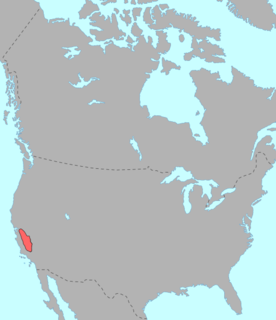
Yokuts, formerly known as Mariposa, is an endangered language spoken in the interior of Northern and Central California in and around the San Joaquin Valley by the Yokuts people. The speakers of Yokuts were severely affected by disease, missionaries, and the Gold Rush. While descendants of Yokuts speakers currently number in the thousands, most of the constituent dialects are now extinct.

Utian is a family of indigenous languages spoken in Northern California, United States. The Miwok and Ohlone peoples both spoke languages of the Utian language family. It has recently been argued that the Utian languages and Yokuts languages are sub-families of the Yok-Utian language family. Utian and Yokutsan have traditionally been considered part of the Penutian language phylum.
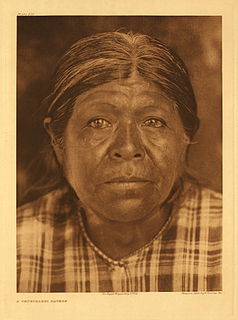
The Yokuts are an ethnic group of Native Americans native to central California. Before European contact, the Yokuts consisted of up to 60 tribes speaking several related languages.
The Karkin language is one of eight Ohlone languages. It was formerly spoken in north central California, but by the 1950s there were no more native speakers. The language was historically spoken by the Karkin people, who lived in the Carquinez Strait region in the northeast portion of the San Francisco Bay estuary.
Estanislao was an indigenous alcalde of Mission San José and a member and leader of the Lakisamni tribe of the Yokuts people of northern California. He is famous for leading bands of armed Native Americans in revolt against the Mexican government and Mission establishments.

Yok-Utian is a proposed language family of California. It consists of the Yokuts language and the Utian language family.

The Chalon people are one of eight divisions of the Ohlone (Costanoan) people of Native Americans who lived in Northern California. Chalon is also the name of their spoken language, listed as one of the Ohlone languages of the Utian family. Recent work suggests that Chalon may be transitional between the northern and southern groups of Ohlone languages.

The Plains and Sierra Miwok were once the largest group of Native American Miwok people, indigenous to California. Their homeland included regions of the Sacramento Valley, San Joaquin Valley, and the Sierra Nevada.
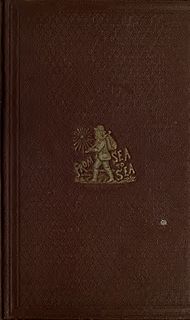
Stephen Powers (1840–1904) was an American journalist, ethnographer, and historian of Native American tribes in California. He traveled extensively to study and learn about their cultures, and wrote notable accounts of them. His articles were first published over a series of years in the Overland Monthly journal, but collected in The Tribes of California (1877) published by the US Geological Survey.
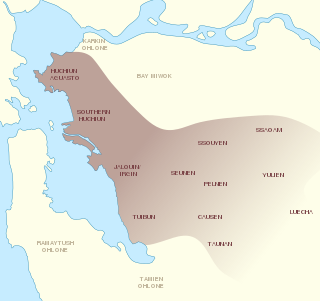
The Chochenyo are one of the divisions of the indigenous Ohlone (Costanoan) people of Northern California. The Chochenyo reside on the east side of the San Francisco Bay, primarily in what is now Alameda County, and also Contra Costa County, from the Berkeley Hills inland to the western Diablo Range.
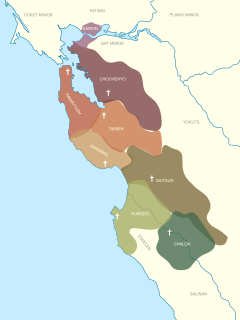
The Ohlone languages, also known as Costanoan, are a small family of indigenous languages spoken by the Ohlone people. The pre-contact distribution of these languages ranged from the southern San Francisco Bay Area to northern Monterey County. Along with the Miwok languages, they are members of the Utian language family. The most recent work suggests that Ohlone, Miwok, and Yokuts are branches of a Yok-Utian language family.
The Tamyen language is one of eight Ohlone languages, once spoken by Tamyen people in Northern California.

The Rumsen are one of eight groups of the Ohlone, an indigenous people of California.
The Karkin people were one of eight Ohlone peoples, indigenous peoples of California.
Delta Yokuts also termed Far Northern Valley Yokuts is an extinct dialect network of Valley Yokuts, a indigenous Yokutsan language of California. Delta Yokuts dialects were spoken from directly northeast of modern Stockton to the confluence of the Merced and San Joaquin rivers near modern Hills Ferry.














